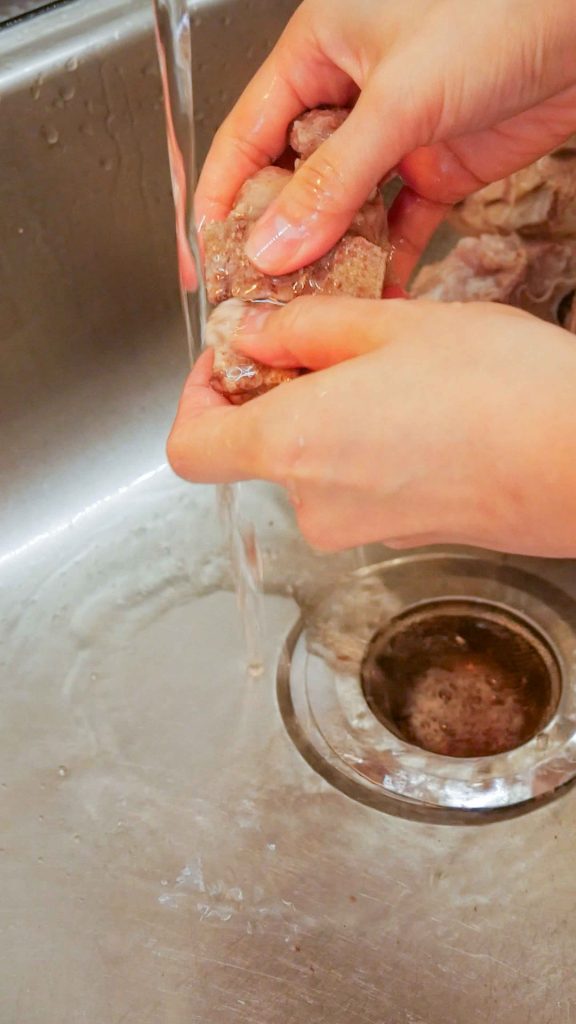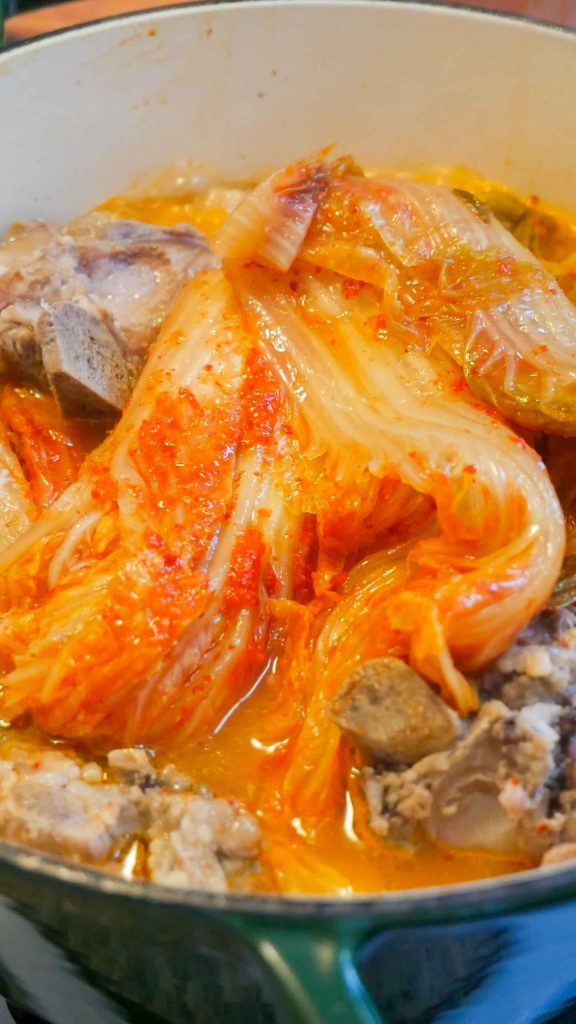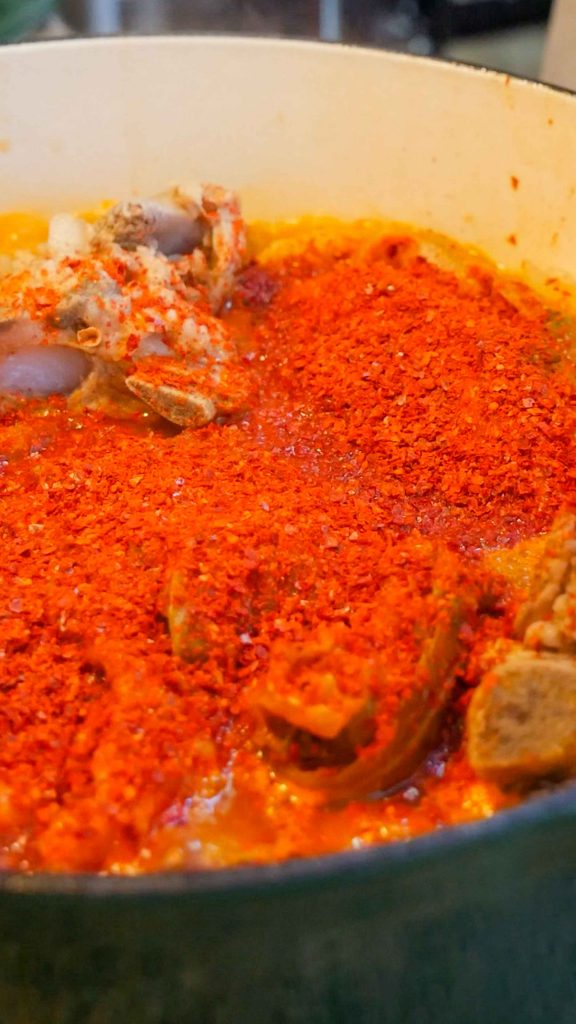Braised pork kimchi jjim is a popular Korean dish that’s made by braising or slow-cooking pork neck bones and well-fermented kimchi, with aromatic seasoning ingredients such as onion, garlic, dried chili peppers, minced garlic, gochugaru, and soup soy sauce. The result is tender, fall-off-the-bone pork swimming in a very flavorful savory-tangy stew! It’s perfect for spicy food lovers or when you need something to warm you up on a chilly day.

What is jjim?
“Jjim” is the Korean term for braised or braising, which is a cooking method that involves a small amount of liquid, slowly cooking the meat at a low temperature for a long period of time. The result is a flavorful dish with tender meat and a thick stew. It is comparable to ’jjigae’ or stew like my kimchi jjigae recipe. Jjigae uses more cooking liquid, resulting in a soupier dish and it also takes less time to make.
I like to eat my pork kimchi jjim with a bowl of white rice! It also goes well with side dishes like:

Why you’ll love this recipe
This braised pork kimchi jjim is Korean comfort food at its finest. It’s richer and deeper in flavor compared to other Korean stews or ‘jjigae’ and doesn’t require much more work. The foundation of this dish starts with the broth, which is made by simmering pork neck bones, aromatics, and seasoning before adding the kimchi.
Now, I usually make this dish when I have a ton of leftover aged sour kimchi. There was a jar of po-gi kimchi that I had forgotten in the back of my fridge, and I immediately knew what to do with it. Due to the slow cooking process, the flavors of the pork, kimchi, and aromatics are intensified, resulting in a rich and delicious stew.
For this recipe, I used pork neck bones which is how my mom makes it. I personally love meat on bones and think it’s way more flavorful than meat without bones. It’s also a cheaper cut, yields more flavor and the marrow from the bones makes this stew rich and thick with collagen. If pork neck bones are not your thing or not accessible to you, a slab of pork belly is a great alternative. Since this dish requires a longer cooking time, it’s important not to cut the pork belly before cooking otherwise it will disintegrate into the stew.
If you have well-fermented kimchi that needs to be used, give this recipe a try!

Braised Pork Kimchi Jjim Ingredients and Substitutions
Pork Broth Ingredients and Substitutions
Pork neck bones: I love using pork neck bones for this dish – it’s how my mom has always made it. As it simmers, the collagen slowly breaks down and gets infused into the soup, making it thick and flavorful. You can substitute this with pork belly, pork shoulders, or pork ribs. If using pork without bones, you don’t need to soak or parboil. Just reduce the cooking time for the broth to 30 minutes.
Mirin: Mirin does wonders in tenderizing the meat. It also helps remove the impurities and unpleasant odors from the meat. This can be substituted with any cooking wine or skipped if you have dietary restrictions.
Onion: Adds a slight spice and sweetness that balances out the flavors of the broth.
Garlic: Adds a delicious garlicky aroma to the broth. Feel free to add as much as you like!
Dried chili peppers: Adds a subtle underlying hint of spice! Feel free to adjust the spice level by adding as much or as little as you like. This can be substituted with fresh chili peppers.
Black peppercorns: Adds complexity and boldness that complements the pork.
Water: For preparing the broth
Kimchi Jjigae Ingredients and Substitutions
Po-gi kimchi: Po-gi kimchi is a type of kimchi where the cabbage leaves are still intact with the stem. You can substitute this with 2 to 3 cups of cut kimchi. The most important factor is that it should be aged, sour, and well-fermented. It is the fermentation or aging process that gives this stew a super rich and complex taste!


Minced garlic: Added for more flavor and aroma.
Gochugaru: For added spice
Soup soy sauce: This type of soy sauce is specifically used for soups and stews. It boosts the savory and umami flavors of the dish. This can be substituted with fish sauce or a pinch of salt.
Firm tofu: For added protein. I like to use firm tofu so that it doesn’t easily break down, but feel free to use any that you prefer or that’s available to you.
Scallions: For added freshness and oniony flavor, and also used as garnish. Its beautiful green color makes the jjim look even more appetizing.

How to prepare Braised Pork Kimchi Jjim
Step 1: Soak the pork
Begin submerging the pork neck bones in cold water and soaking for 1 hour. After 1 hour, drain the pork.


Step 2: Boil the pork
Fill a large heavy-bottomed pot with water then add the pork bones to the pot. The pork bones should be completely submerged. Add mirin then bring to a boil for 10 minutes.


Step 3: Clean the pork bones
Drain the pork bones and rinse each bone, making sure to wash away the gunk in between the crevices.

Step 4: Simmer the pork
To a clean pot, add the parboiled pork bones, roughly chopped onions, garlic cloves, dried chili peppers, whole black peppercorns, water, and salt. Cover and simmer on medium-low heat for 45 minutes.



Step 5: Add the kimchi
Add the kimchi to the pot along with gochugaru, minced garlic, and soup soy sauce. Cover and simmer for another 45 minutes.




Step 6: Add the tofu and scallions
Add sliced tofu and scallions. Simmer for 3 to 5 minutes.

Step 7: Cut the kimchi and serve
Using a scissor, cut the kimchi into bite-sized pieces. Serve and enjoy!

Preparation tips for Braised Pork Kimchi Jjim
Here are some helpful tips for making the most delicious braised pork kimchi jjim every time:
- Parboiling the pork neck bones will result in a clearer and cleaner tasting stew. You want to remove as many impurities as you can by soaking the bones to extract blood and then parboiling it. Be sure to get into the nooks and crannies of the bones when washing them.
- Take time to skim off the foamy scrum that will float as you boil the pork. Use a spoon, a slotted spoon, or a skimmer.
- Use a heavy-bottomed pot with a tight-fitting lid, like a dutch oven. These types of pots retain heat very well, making them great for slow and long cooking. They’re also great for browning the meat which might be useful for other recipes, especially for braising. Dutch ovens are quite versatile—you can also use them for deep frying, stewing, making rice, and even baking.
- You can prepare this dish in advance, which will actually make it even more flavorful as it will allow the flavors to develop as it sits. If you want, you can make it a day in advance and it’ll be even tastier the next day.
- This dish is typically served with rice and I recommend making extra because you will most definitely need it! It’s rich, hearty, and super flavorful and you’ll need rice to balance it all out.

Frequently Asked Questions
What is the difference between kimchi jjigae and pork kimchi jjim?
Jjigae is the term that refers to Korean stew, while jjim is the term that refers to braised or braising. Both dishes involve cooking meat and vegetables in liquid. However, braising is a longer cooking process, which means more liquid evaporates. As a result, braised dishes have a thick, condensed, and flavor-packed sauce compared with stews which are more liquidy. You get a richer and more flavorful sauce out of braising, and the collagen from the bones in this recipe also contributes to the sauce’s thick consistency.
What cut of pork is best for kimchi jjim?
I like to use pork neck bones because that’s how my mom makes it, and I personally love meat on bones. I think bony cuts of pork are more tender and flavorful, plus they’re also cheap. Other options are pork belly, pork shoulder, or ribs. Whichever you use, the final result will still be just as flavorful and tender. If using pork without bones such as pork belly and pork shoulder, you don’t need to soak or parboil. Just reduce the cooking time for the broth to 30 minutes.
Can I use fresh kimchi?
Aged kimchi is what provides this dish with that delightful complex flavor. But if you want to make this using fresh kimchi, you can. The flavor might just not be as deep and complex as compared with using aged kimchi. You might also want to consider adding a splash of vinegar to compensate for the lack of sourness from aged kimchi.
How to store leftover pork kimchi jjim?
Let the leftovers cool to room temperature. Store them in airtight containers or directly in the pot then transfer them to the fridge for up to two days. Reheat in the microwave or on the stovetop.
Looking for more easy delicious hearty and comforting recipes?
Korean Beef Radish Soup — Korean beef radish soup is a simple yet hearty and flavorful soup. It’s made with thinly sliced beef, Korean radish, and aromatics served in a delicious and comforting soup. It’s both hot and refreshing, exactly what you need on a chilly day or when you need a pick-me-up.
Mille Feuille Nabe — Mille feuille nabe is a popular Japanese dish made of layered napa cabbage and thinly sliced pork cooked in a seasoned dashi broth and served hot pot style. The name of the dish translates to ‘thousand layers hot pot’, which refers to the beautiful layers of thinly sliced pork and cabbage stacked in the pot.
Char Siu Pork Noodle Soup — One of my childhood favorites. It’s made with fresh rice noodles, yu choy, scallions, a flavorful and aromatic soup base, and pork shoulder seasoned with char siu sauce. It’s also got Shaoxing wine, five spice powder, and fermented bean curd.
Suan Cai Yu — ‘Suan cai yu’ or Sichuan fish with pickled mustard greens is Chinese comfort food at its finest. The combination of fragrant aromatics like ginger, garlic, and scallions with the spicy and numbing Sichuan peppers, and the tangy pickled mustard greens beautifully complement the soft and delicate fish.
Korean Pork Bone Soup — Also known as ‘gamjatang’, this is a hearty and comforting dish made with tender fall-off-the-bone meat, and an assortment of vegetables, served in a spicy flavorful soup. It’s a dish that’s meant to be shared and something I crave when I get together with my family or celebrate a special occasion.

Braised Pork Kimchi Jjim Recipe – 등뼈 김치찜
Ingredients
Pork Broth
- 2 1/2 lbs pork neck bones
- 2 tbsp mirin substitute with cooking wine
- 1 medium onion roughly chopped
- 1 whole head garlic about 14-15 garlic cloves
- 4 dried chili peppers optional
- 10 whole black peppercorns about 1/4 tsp
- 12 cups water
Kimchi Jjigae
- 2-3 po-gi kimchi (whole leaf kimchi) substitute with 2 to 3 cups of cut kimchi
- 6 garlic cloves minced
- 2 tbsp gochugaru adjust to taste
- 1 tbsp soup soy sauce adjust to taste
- 1/2 block firm tofu sliced
- 2 scallions chopped
Instructions
- Begin submerging the pork neck bones in cold water and soaking for 1 hour. After 1 hour, drain the pork.
- Fill a large heavy-bottomed pot with water then add the pork bones to the pot. The pork bones should be completely submerged. Add mirin then bring to a boil for 10 minutes.
- Drain the pork bones and rinse each bone, making sure to wash away the gunk in between the crevices.
- To a clean pot, add the parboiled pork bones, roughly chopped onions, garlic cloves, dried chili peppers, whole black peppercorns, water, and salt. Cover and simmer on medium-low heat for 45 minutes.
- Add the kimchi to the pot along with gochugaru, minced garlic, and soup soy sauce. Cover and simmer for another 45 minutes.
- Add sliced tofu and scallions. Simmer for 3 to 5 minutes.
- Using a scissor, cut the kimchi into bite sized pieces. Serve and enjoy!